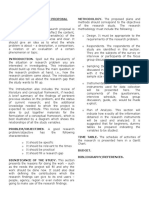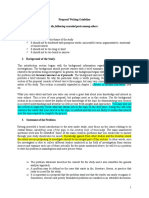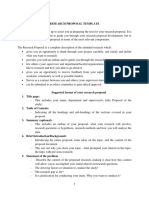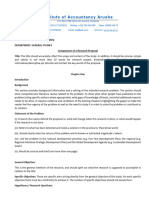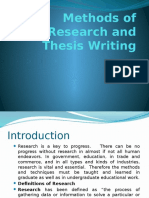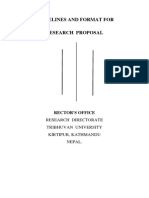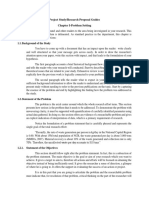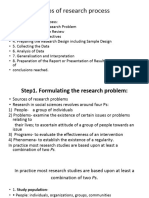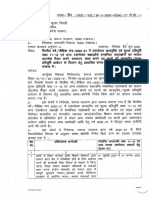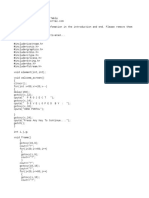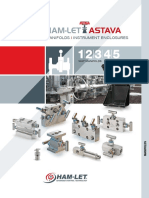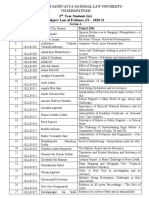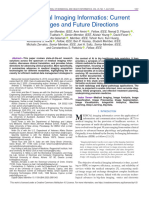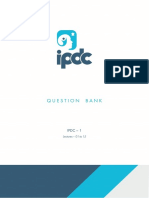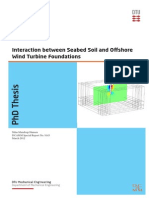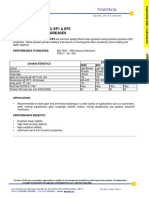Dissertation Report Format
Department OF PUBLIC ADMINISTRATION
University of lucknow
For the students of M.A. Semester -IV who allotted under the Supervision of
DR. UTKARSH MISHRA
Cover Page (Title Page)
University name and logo
Title of the report
Student's name, registration number, and program
Supervisor’s name and designation
Certificate
Declaration
Acknowledgement
Thank individuals or organizations who supported the internship and report
preparation.
Abstract
Table of Content
List all sections and sub-sections with page numbers.
List of Tables
List of Figures
Chapter -1 Introduction of study
Background & Historical Perspective
Importance
Purpose
Brief overview of the issue
Scope of the report.
1
�Chapter - 2 Review of Literature & Methodology
In general, the research plan of a research student/academician may cover the following
essential sections:
1. Introduction: The introduction of a research plan or proposal should place the
research problem in its historical perspective; state the need for studying it, and the
researcher's precise interests in the study of the problem.
2. Statement of the problem: The research problem should be well defined, pointing
out its core nature and its importance. The issue relating to the problem may also be
stated. This statement gives direction to the research process.
3. Review of the previous studies: On the selected theme, some studies might have
been previously made by other. A review of available literature will bring out
information on them. The salient features of those studies may be briefly described and
the gaps may be pointed out. Does the selected study fill in the gap? Or is it a replication
of an earlier study made elsewhere? In the later case, the justification for studying the
same problem may be stated with reference to environmental differences, temporal
difference, etc.
4. Scope of the study: A complete study of any problem is well nigh unmanageable. It
would entail such an over-whelming volume of data that it would require more than a
student's life-time to comprehend and complete the study. Therefore, the scope and
dimensions of the study should be delimited with reference to the topical scope breadth
and depth, geographical area to be covered. reference period, the type of
institutions/respondents to be studied, the issues to be analysed, etc. The purpose of this
demarcation is to make the study manageable in terms of the researcher's aim, interest
and competence and available techniques, time, finance and facilities.
Research scholars are invariably ambitious, take up a vast study, not knowing
the time and other requirements, and later find it difficult to complete the work within
the prescribed time limit. In their anxiety to complete the work, they are forced to
sacrifice its depth and quality. Therefore, it is essential to delimit the study from the
2
� stand point of manageability. Yet it should provide the researcher with an opportunity
to gain a systematic experience of planning and conducting a research sty make scene
contribution to the fund of knowledge.
5. Objective of the study: The specific objectives of the study should be stated clearly.
refer to the questions to which the researcher proposes to seek answers through the
study. Alto there is no limit to the number of research objectives, it is desirable to limit
the objectives reasonable number. What is reasonable depends upon the time limitation,
resource constraints, etc. It is wise to pick objectives that are challenging but not
impossible to achieve.
The objectives may be stated as under:
To study the extent of..............................
To identify the factors which influence..............................
To examine the nature of relation between..........................
To investigate the impact of..........................
To identify the causes of..........................
The statement of objectives should not be vague or nebulous like "to study
industrial marketing in India"; "to explore unemployment in India" and the like.
These statements are vague, as they fail to specify what exactly are aimed at.
The statement should be specific and indicate the exact purpose of the study. Such
precise statements give function guidelines to the research process. The statement of
objective may be followed by a statement of the investigative questions relating to each
of the research objectives.
6. Conceptual model: This section is the heart of the research plan. This is where the
researcher formulates and develops the structure of relationships among the variables
he is investigating. The logical connection of the variables is delineated; the
assumptions, and propositions used to develop the explanatory framework are included.
The entire research project rests upon the theoretical framework
3
�7. Hypotheses: These are logically deduced from the theoretical framework above.
These refo to the anticipated outcome or possible answers to the research questions.
They should be conceptually clear, specific and simple.
8. Operational definition of concepts: The major concepts used in the title of the
study, its objectives, the investigative questions and the hypotheses should be
identified. Each of them should be defined in operational terms pertinent to the
measurement criteria or operations.
9. The significance of the study: It is important to point out the relevance and
significance of the investigation. What would be the value of the findings of the study
for policy formulation, theory or practice? Can the findings contribute to the enrichment
of theory and/or to the solution of some practical problems? A careful statement of the
value of the study and the posible application of its finding helps to justify its
importance and social relevance.
10. Geographical area to be covered: The territorial area to be covered by the suusty
should be decided and specified in the plan come area to be chosen depends on the
purpose of the study and time and other resources available,
11. Reference period: This period may be one year, two, or more years depending on
the nature of the study and availability of data. The period should be longer, say 5 or
10 years, if the study aims at making a trend analysis of an activity like production or
sale or profitability.
12. Methodology: In this section, the overall typology of the design experimental,
descriptive, survey, case study or historical study collection of data is specified. Further,
the methods or methods to be adopted observation, interviewing or mailing are
specified.
13. Sampling plan: If the study requires collection of primary data from the field, the
universe most be delineated, and the methods of sampling to be used for drawing the
sample from the universe and the sample size must be stated,
4
� 14. Tools for gathering data: In this section, the tools, to be used for gathering data
review schedule/guide or questionnaire or check list, etc. are listed and each of them is
described. The twols chosen should be appropriate to the methods to be adopted for
gathering data.
15. Plan of analysis: The statistical techniques to be used for analyzing the various
techniques should be specified. The application of appropriate techniques is essential
for testing hypothesis and drawing inferences.
Chapter - 3 & 4 Issue Specific Chapter (Which should highlight the
dimension of Issue or Topic)
Chapter - 5 Analysis
With presentation and analytical tools eg. - PowerPoint, Keynote, Prezi, Canva,
Tableau Public, Google Slides, Infogram, Python (Pandas, NumPy, SciPy), R
(ggplot2), SPSS, NVivo, Gephi, MATLAB, Microsoft Excel, VADER, TextBlob
Chapter - 6 Conclusion & Recommendations
Summary of key findings and learnings
Overall assessment of the research experience
Suggestions for the issue and problem based on observations and analysis
Recommendations for future researchers.
Bibliography -
Follow the APA Format Guidelines.
Appendices
Supporting documents (e.g., work samples, surveys, interview transcripts)
Note - Other Guidelines
Length: Typically, 35-50 pages & it should be typed.
Use APA style referencing at the last of each chapter.
Clarity and Conciseness: Ensure the report is clear, concise, and free of jargon.
Proofreading: Check for grammatical errors, typos, and ensure proper formatting.
Visual Aids: Use tables, charts, and figures to support and illustrate points.
Confidentiality: Respect the confidentiality policies of the host organization.
Use Foot Notes as per the need.







